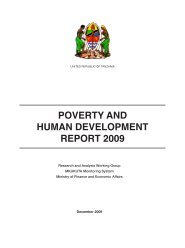Download PDF (4.08 MB) - ReliefWeb
Download PDF (4.08 MB) - ReliefWeb
Download PDF (4.08 MB) - ReliefWeb
You also want an ePaper? Increase the reach of your titles
YUMPU automatically turns print PDFs into web optimized ePapers that Google loves.
47<br />
cessful exit strategies include mechanisms to support participants’ evolution to reliance<br />
on market-based mechanisms. The project’s exit strategy and communication strategy<br />
should be closely linked, so that from the start participants are encouraged to plan for<br />
the long term. The exit strategy should clearly articulate how the project is expected to<br />
contribute to progress toward the goals of national recovery and development strategies<br />
and plans. By emphasizing linkages with microfinance institutions, training institutions,<br />
business development services, and government-led recovery and development programmes,<br />
the exit strategy can facilitate the sustainability of livelihoods after the end of<br />
the project. Exit strategies should also link start-up assistance to interventions for policy<br />
and institutional development that is supported by UNDP and other partners (Track B<br />
and C interventions) within national frameworks.<br />
Box 3.4. Start-up assistance in Somalia<br />
Somalia’s Berdale District has borne the brunt of the country’s civil war. In response, UNDP Somalia and the Somali Association for Rehabilitation and<br />
Development (SARD) have established the Area-Based Early Recovery (ABER) project, which targets five villages and the town of Berdale. The project assists<br />
281 economically and/or socially vulnerable households, which were identified and selected by a Village Project Implementation Committee. The livelihood<br />
interventions in the ABER project consist of agricultural development, the establishment of small businesses, and infrastructure rehabilitation.<br />
Start-up assistance has made a real impact on the lives and livelihoods of participating households. The following are some examples:<br />
• A farmer, Ibrahim, received a start-up package of seeds, poultry, and the use of a tractor to revive his farm. He has grown a number of small-scale crops,<br />
which he sells, along with eggs. The income he earns has enabled him to feed his family more nutritious food and to purchase essential commodities, such<br />
as medicine and clothing.<br />
• Fadumo, a widow with three children, received a start-up package of eight goats. Two more goats were born, increasing the number to ten. The goats<br />
provide ten litres of milk per day. Fadumo’s family consumes half of this milk, and she sells the other half to members of her community. As a result of the<br />
start-up support, Fadumo has diversified her family’s food intake to include meat and some fruit, and her children now have improved health and clean<br />
clothes.<br />
• Hassan, a young man who had been unemployed for more than a year and was contemplating joining a militia group, perceived an unmet demand in<br />
Berdale for baked goods. He established a small bakery with two colleagues. The bakery had a limited production capacity of 400 rolls of bread per day.<br />
It was not hygienically sound, and the ovens, tables, and other materials were dirty and broken. Hassan and his colleagues received start-up materials to<br />
rehabilitate the bakery and to sell healthy bread to the public. With this assistance, the bakery’s production capacity increased to 1,200 rolls, the quality of<br />
the bread improved, and the bakery started to generate a profit. The project has dissuaded Hassan from joining a militia group and has also enabled two<br />
of Hassan’s children to attend school while also providing a vital service to the community.<br />
• Hamida, a mother of four with inadequate shelter for her family, had gained experience as a milling machine operator. She and two other women received<br />
a start-up package including a milling machine, various materials, and a two-day training session on business management. With this assistance, these<br />
started a milling and grinding business. Hamida’s family now lives in suitable housing, and the community in Berdale benefits from the services that she<br />
provides.<br />
3.2.3 Addressing crosscutting priorities<br />
As with all livelihoods and economic recovery programmes, those programmes that offer<br />
targeted self-employment support can successfully promote gender equity and women’s<br />
empowerment, reduce conflict and disaster risk, strengthen market activity, and avoid<br />
causing harm in any of these areas only if they are designed carefully, and with these<br />
objectives in mind. This section provides points to consider vis-à-vis addressing these<br />
crosscutting priorities in start-up assistance programming.<br />
Gendersensitivity. Gender-sensitive programming for targeted self-employment takes<br />
into account the needs, concerns, and priorities of both women and men in project<br />
design, and it promotes selection criteria that enable the distribution of start-up grants<br />
and packages to both women and men. Projects often are designed to support home-<br />
Livelihoods & Economic Recovery in Crisis Situations





